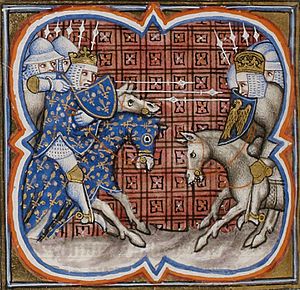Capetian–Plantagenet rivalry facts for kids
Quick facts for kids Capetian–Plantagenet rivalry |
|||||||||
|---|---|---|---|---|---|---|---|---|---|
| Part of the Anglo-French Wars | |||||||||
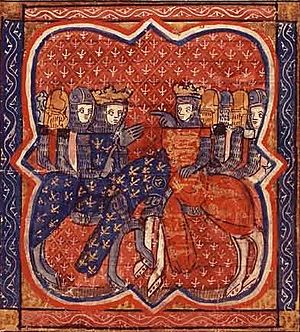 Philip Augustus and Richard the Lionheart at the Third Crusade |
|||||||||
|
|||||||||
| Belligerents | |||||||||
|
|||||||||
| Commanders and leaders | |||||||||
The Capetian–Plantagenet rivalry was a long series of fights and disagreements between two powerful royal families. It lasted for 100 years, from 1159 to 1259. The House of Capet ruled France, and the House of Plantagenet (also called the House of Anjou) ruled England.
The main goal of the French kings was to stop the Plantagenets from becoming too powerful. Some historians even call this period the "First Hundred Years' War".
Even though the English kings ruled England, their lands in France were very important. These French lands were much larger than the areas directly controlled by the King of France. However, the King of France was still the overlord (like a higher boss) of the English kings for these lands.
This conflict was mostly a French affair because:
- Both royal families were originally French.
- Most of the English army's nobles were from France.
- The foot soldiers for the English king were recruited from French regions.
The many wars helped the Capetian kings of France slowly take back control of their own kingdom. Before this, their power over many of their vassals (nobles who owed them loyalty) was weak. The conflict ended with the Treaty of Paris in 1259. After this, the English kings still had some land in France, but they remained vassals to the French kings until 1360.
Contents
Henry II Expands His Power
In 1150, Henry II received the Duchy of Normandy from his father. When his father died in 1151, Henry also became the Count of Anjou and Maine.
On May 18, 1152, he married Eleanor of Aquitaine. This marriage made him the Duke of Aquitaine, a very large and rich region in France.
Then, in 1153, a treaty recognized him as the next king of England. When King Stephen died in 1154, Henry became King Henry II of England. He was crowned in Westminster Abbey in December.
Henry wanted to expand his lands even more. In 1159, he tried to take Toulouse with help from Aragon. But the French King Louis VII helped Toulouse, so Henry had to pull back. He did manage to take parts of Quercy and Cahors.
Henry also gained more control over the Duchy of Brittany. He made the Duke step down and married his own son to the Duke's daughter. This put Brittany under Henry's influence.
Even though Henry II was very powerful, he faced some big challenges:
- He had a major disagreement with Thomas Becket, the Archbishop of Canterbury. Becket opposed the king's attempts to control the Church. Becket was killed in his cathedral in 1170 by knights who wanted to please the king. Henry later made peace with the Church.
- His own sons rebelled against him! They wanted to inherit his lands. His three oldest sons, their mother Eleanor of Aquitaine, and the King of France all joined against him. Henry won these fights and became even stronger in Europe.
Henry II was a respected ruler, and many European leaders sought his advice. But the new King of France, Philip Augustus, saw Henry's huge lands as a threat. Philip allied with Henry's sons, Richard and John. Henry II was forced to name Richard as his only heir. Henry died two days later in 1189. Richard inherited all of his father's vast territories.
Richard the Lionheart Battles Philip Augustus

When Philip Augustus became king in 1180, his kingdom was quite small compared to the huge Angevin Empire ruled by the English king. Philip worked to make his own kingdom stronger. Then, he encouraged Henry II's sons to rebel against their father. He even became friends with Richard the Lionheart.
After some fighting, a truce was signed in 1188. When Henry II died in 1189, Richard became King of England. Both Richard and Philip then left for the Third Crusade.
Philip Augustus returned early from the crusade in 1191. He then encouraged Richard's brother, John Lackland, to rebel against Richard. Philip used Richard's absence to make a very good deal for France. John hoped to become King of England with Philip's help. In 1193, John promised loyalty to Philip.
When Philip attacked the Plantagenet lands, John gave up parts of eastern Normandy to the French king. Philip used his military skills and clever diplomacy to keep Richard at bay.
Richard the Lionheart stayed on the crusade longer. He recaptured important cities in Palestine and restored the Latin Kingdom of Jerusalem. He made a truce with Saladin and sailed home in 1192. But storms forced him to land in Europe, where he was captured by his enemies.
The German Emperor held Richard for a huge ransom. Richard's mother, Eleanor of Aquitaine, paid most of it, and Richard was finally released in February 1194.
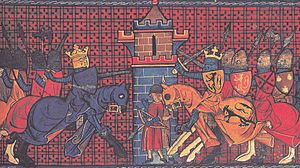
Richard immediately fought back. He pushed Philip's forces back in the Battle of Fréteval. Philip had to give up most of his recent gains in a treaty in 1196. Fighting started again in 1197, and Richard won again. He invaded the Vexin region, leading to an English victory at the Battle of Gisors. It was here that the famous saying "Dieu et mon droit" (God and my right) was supposedly first used by King Richard.
Both kings looked for more support. The new Pope, Pope Innocent III, wanted them to stop fighting and go on another crusade. But the conflict ended suddenly. In 1199, during a siege, Richard was hit by a crossbow bolt. He died a few days later, at 41 years old.
Philip Augustus's Clever Moves
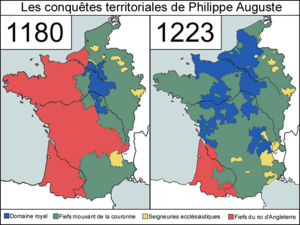
John Lackland became king after his brother Richard died. But John had a rival: his 12-year-old nephew, Arthur of Brittany. Philip Augustus supported Arthur against John. Philip received Arthur's promise of loyalty for lands like Anjou and Maine. This gave Philip a strong position to negotiate with John.
In 1200, they signed the Treaty of Le Goulet. This treaty aimed to settle the English claims to French lands, except for Aquitaine. It was also sealed by the marriage of Philip's son, Louis, to John's niece.
However, the fighting did not stop. Philip again supported Arthur. He called John, as his vassal, to appear before the French court for his actions in Aquitaine. John did not show up. So, the French court declared that John's French lands were taken away.
In 1202, Philip attacked Normandy. Arthur attacked Poitou but was captured by King John. Arthur of Brittany disappeared a few months later, likely murdered in 1203. Philip then supported Arthur's vassals and continued his attacks in Normandy. Philip demanded Arthur's sister be released, but John refused.
Philip began to destroy the Norman castles. He took Le Vaudreuil and started the Siege of Chateau Gaillard in September 1203. John made a mistake by leaving Normandy for England in December 1203. Chateau Gaillard fell on March 6, 1204.
Normandy was now open for Philip to conquer. He quickly took Falaise, Caen, Bayeux, and Rouen by June 1204. John Lackland did not send help. Philip had conquered Normandy in just two years. To secure his new land, Philip built a strong castle in Rouen.

Philip then moved to the Loire Valley. He took Poitiers in August 1204, and Loches and Chinon in 1205. John and Philip finally agreed to a truce in 1206. Philip worked to make his new conquests stable. He even ordered that Norman money be used instead of Angevin money.
From 1206 to 1212, Philip Augustus made his control stronger. His power was accepted in Champagne, Brittany, and Auvergne. But the counties of Boulogne and Flanders were still difficult.
Renaud de Dammartin, the Count of Boulogne, was a big problem. Even though Philip had given him favors, Renaud kept talking with Philip's enemies. Philip suspected Renaud when he started building forts in western Normandy. In 1211, Philip attacked and took Renaud's lands. Renaud fled, no longer an immediate threat.
Philip Augustus's Great Victory
Philip Augustus's amazing success soon made all his rivals unite against him. In 1212, a powerful group formed. King John of England allied with his nephew, Otto IV, Holy Roman Emperor. Renaud de Dammartin was the main planner of this group. He went to Germany to get support from Otto and England.
Fighting between Philip and John started again right away. Philip planned to invade England, but his fleet was attacked in May 1213. Philip and his son Louis then fought against the counties of Boulogne and Flanders. Many northern cities were destroyed.
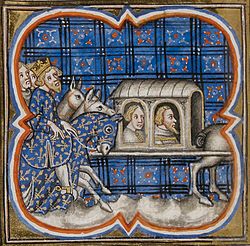
In February 1214, John arrived in France, hoping to surprise Philip. John gained supporters in Limousin and Poitou. In May 1214, he took Angers. Philip, who was busy fighting the English, Flemish, and German forces in Flanders, sent his son Louis to fight John. John's allies forced him to retreat, and the English were defeated.
The final big battle was unavoidable. On Sunday, July 27, 1214, Philip's army was at Bouvines. Otto decided to attack, hoping to surprise them. Philip's army was surprised but quickly got ready to fight.
The French right side fought the Flemish knights. In the center, where the fighting was fiercest, Philip and Otto fought in person. Philip was knocked off his horse but was protected by his knights. He got a new horse and kept fighting until Otto ordered a retreat. On the left, Philip's supporters captured Renaud de Dammartin and William Longespée, who led the English knights.
Philip won a decisive victory, even though his army was smaller. The Emperor fled. Philip's men captured 130 prisoners, including five counts, like the hated Renaud of Dammartin and the Count of Flanders.
The alliance against Philip broke apart after this defeat. On September 18, 1214, Philip signed a truce for five years. King John returned to England. By the Treaty of Chinon, John Lackland gave up all his lands north of the Loire River. These lands, including Berry, Touraine, Maine, and Anjou, became part of the French royal domain. This made France much larger and safer.
Prince Louis's Trip to England
After the victory at Bouvines, Philip's son, Louis, wanted to go even further against John of England. Louis argued that John should no longer be king because of his past actions. At the request of English nobles who were rebelling against John, Louis led an expedition to conquer England.
In May 1216, Louis landed in England with many troops. He conquered much of the English kingdom, including London, where he declared himself King of England. Only a few places like Windsor and Dover resisted.
However, the Pope strongly supported John, and Louis was excommunicated (kicked out of the Church). Then, John died suddenly in October 1216. John's former allies quickly crowned his nine-year-old son, Henry III. The new Pope also supported Henry. Many English bishops stopped supporting Louis and the rebels.
Louis went back to France for more support and returned to England in 1217. But this time, his forces were defeated in the Battle of Lincoln. French reinforcements trying to cross the English Channel were also destroyed in the Battle of Sandwich. Louis agreed to make peace in June 1217, and his excommunication was lifted.
Philip Augustus's role in this expedition was unclear. He didn't officially support it, but it's likely he secretly agreed.
After the Battle of Bouvines, there was peace in northern France. Philip Augustus continued to expand his influence by taking advantage of inheritance issues. He gained control over lands like Issoudun and Alençon.
The kingdom was very rich at the end of Philip Augustus's reign. He died on July 14, 1223, in Mantes. His body was brought to Paris and buried in Saint-Denis. For the first time, a King of France's body was displayed with all his royal symbols for people to see before burial.
Louis VIII's Conquests in France
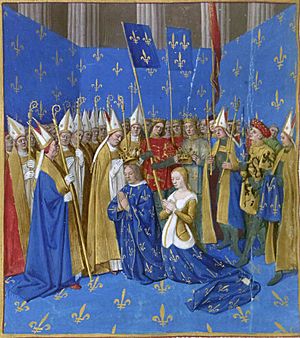
Grandes Chroniques de France, illuminated by Jean Fouquet. BNF Fr.6465 f.247
Louis VIII, known as "the Lion," gained fame during his father's reign by winning the Battle of La Roche-aux-Moines in 1214. Although he was defeated in England in 1217, he gave up his claim to the English throne in exchange for a large sum of money.
Louis VIII later claimed that the English had not kept all their promises from the 1217 treaty. Since King Henry III of England was still a child, Louis decided to take the last English lands in France.
He quickly conquered the Aquitaine region. Cities like Poitou, Saintonge, Périgord, and Angoumois fell one after another. Louis VIII took control of all the land up to the Garonne River. To control trade, the French besieged the important port city of La Rochelle in 1224. The city surrendered within a month. The only lands left for the English king in France were Bordeaux and Gascony.
The Reign of Saint Louis

In 1230, King Henry III led an army to France to try and get back the Plantagenet lands. But he was pushed back and had to return to England the next year. In 1242, Henry was again at war with the King of France, Louis IX (also known as Saint Louis). Henry tried to take advantage of a dispute over land in Poitou.
However, Henry was defeated in two battles fought within two days. These were the Battle of Taillebourg and another decisive battle near Saintes. Louis then besieged the city of Saintes, which ended the short Saintonge War.
Because Henry's wars in France were failing and costing a lot of money, the English nobles wanted to bring back the power of the Magna Carta. This was a document that limited the king's power. As tensions grew, both sides in England asked the King of France for support.
To get Louis's help, Henry signed the Treaty of Paris in 1259. In this treaty, Henry agreed to accept the loss of the French lands that had been taken from him and his father since 1202. He also agreed to pay homage (show loyalty) to the French king for the lands he still held.
This treaty ended Henry's hopes of rebuilding the old Angevin Empire. After the treaty, the two kingdoms generally had a period of peace. The English kings regularly paid homage to the King of France. Both kingdoms then focused on fighting their smaller neighbors. England fought in the First War of Scottish Independence, and France fought in the Franco-Flemish War.
Final Agreement Under Philip the Fair
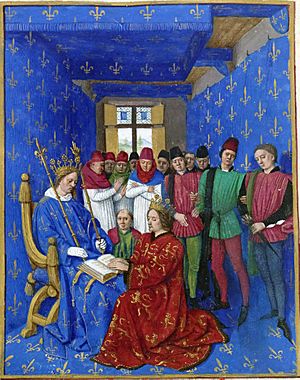
The "First Hundred Years' War" officially ended with the Treaty of Montreuil-sur-Mer, signed on June 19, 1299. This treaty was between Philip IV the Fair of France and Edward I of England. It gave Guyenne back to the King of England.
The treaty also arranged two important marriages:
- Philip's sister, Margaret, married Edward I.
- Philip's daughter, Isabella, married Edward I's son, also named Edward.
On May 20, 1303, France and England signed the Treaty of Paris (1303), which confirmed the Montreuil treaty.
Interestingly, Edward III, who was the son of Isabella and Edward II, would later use his family connection to Philip the Fair to claim the throne of France. So, the very agreement that ended the "first" Hundred Years' War actually helped cause the "second" one! The War of Saint-Sardos, a conflict between the two kingdoms in 1324, was a sign of the bigger war to come.
See also


